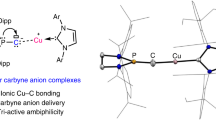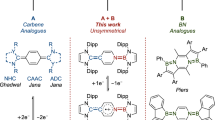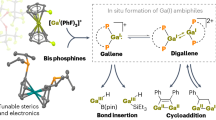Abstract
The singlet states of cyclopentadienyl (Cp) cations are considered as true prototypes of an antiaromatic system. Unfortunately, their high intrinsic reactivity inhibited their isolation in the solid state as a salt, and controlled reactions are also scarce. Here we present the synthesis and solid state structure of the room-temperature-stable Cp cation salt [Cp(C6F5)5]+[Sb3F16]−. Although the aromatic triplet state of the [Cp(C6F5)5]+ cation is energetically favoured in the gas phase according to quantum chemical calculations, coordination of the cation by either [Sb3F16]− or C6F6 in the crystal lattice stabilizes the antiaromatic singlet state, which is present in the solid state. The calculated hydride and fluoride ion affinities of the [Cp(C6F5)5]+ cation are higher than those of the perfluorinated tritylium cation [C(C6F5)3]+. Reactions of [Cp(C6F5)5]+[Sb3F16]− with CO, which probably yields the corresponding carbonyl complex, and of radical Cp(C6F5)5∙ with selected model substrates (Cp2Fe, (Ph3C∙)2 and Cp*Al) are also presented.

This is a preview of subscription content, access via your institution
Access options
Access Nature and 54 other Nature Portfolio journals
Get Nature+, our best-value online-access subscription
$29.99 / 30 days
cancel any time
Subscribe to this journal
Receive 12 print issues and online access
$259.00 per year
only $21.58 per issue
Buy this article
- Purchase on Springer Link
- Instant access to full article PDF
Prices may be subject to local taxes which are calculated during checkout



Similar content being viewed by others
Data availability
All data generated or analysed during this study are included in this published article (and its Supplementary Information files). The structures of B, C6(C6F5)6, 1a+, 1b+, 2a‒b, 3a‒c, 5 and 6 in the solid state were determined by single-crystal X-ray diffraction and the crystallographic data have been deposited with the Cambridge Crystallographic Data Centre (CCDC) with identifiers 2246848 (1a+), 2246849 (1b+), 2246850 (2a), 2246851 (2b), 2246852 (3a), 2246853 (3b), 2246854 (3c), 2246857 (5), 2246858 (6), 2246859 (B) and 2246860 (C6(C6F5)6). Copies of the data can be obtained free of charge on application to the CCDC.
Code availability
DFT and double-hybrid DFT methods, as implemented in the quantum chemistry program packages Gaussian1676, Amsterdam Density Functional (ADF)77 and Orca 5.0.078, were used to calculate molecular geometries, orbital energies, charges, natural bond orbitals and NICS values. All data generated or analysed are included in the Supplementary Information file.
References
Faraday, M. XX. On new compounds of carbon and hydrogen, and on certain other products obtained during the decomposition of oil by heat. Phil. Trans. R. Soc. 115, 440–466 (1825).
Kaiser, R. ‘Bicarburet of hydrogen’. Reappraisal of the discovery of benzene in 1825 with the analytical methods of 1968. Angew. Chem. Int. Ed. Engl. 7, 345–350 (1968).
Kekulé, A. Ueber die s.g. gepaarten Verbindungen und die Theorie der mehratomigen Radicale. Justus Liebigs Ann. Chem. 104, 129–150 (1857).
Kekulé, A. Ueber die constitution und die metamorphosen der chemischen verbindungen und über die chemische natur des kohlenstoffs. Justus Liebigs Ann. Chem. 106, 129–159 (1858).
Schultz, G. Feier der deutschen chemischen gesellschaft zu ehren August Kekulé’s. Ber. Dtsch. Chem. Ges. 23, 1265–1312 (1890).
Willstätter, R. & Waser, E. Über cyclooctatetraen. Ber. Dtsch. Chem. Ges. 44, 3423–3445 (1911).
Balaban, A. T., Schleyer, P. V. R. & Rzepa, H. S. Crocker, not Armit and Robinson, begat the six aromatic electrons. Chem. Rev. 105, 3436–3447 (2005).
Hückel, E. Quantentheoretische beiträge zum benzolproblem. Z. Physik 70, 204–286 (1931).
Breslow, R. & Yuan, C. The sym-triphenylcyclopropenyl cation, a novel aromatic system. J. Am. Chem. Soc. 80, 5991–5994 (1958).
Breslow, R., Groves, J. T. & Ryan, G. Cyclopropenyl cation. J. Am. Chem. Soc. 89, 5048 (1967).
Katz, T. J. The cycloöctatetraenyl dianion. J. Am. Chem. Soc. 82, 3784–3785 (1960).
Breslow, R. Novel aromatic and antiaromatic systems. Chem. Rec. 14, 1174–1182 (2014).
Kass, S. R. Cyclopropenyl anion: an energetically nonaromatic ion. J. Org. Chem. 78, 7370–7372 (2013).
Wu, J. I. C., Mo, Y., Evangelista, F. A. & von Ragué Schleyer, P. Is cyclobutadiene really highly destabilized by antiaromaticity? Chem. Commun. (Camb.) 48, 8437–8439 (2012).
Breslow, R. & Hoffman, J. M. Antiaromaticity in the parent cyclopentadienyl cation. Reaction of 5-iodocyclopentadiene with silver ion. J. Am. Chem. Soc. 94, 2110–2111 (1972).
Saunders, M. et al. Unsubstituted cyclopentadienyl cation, a ground-state triplet. J. Am. Chem. Soc. 95, 3017–3018 (1973).
Breslow, R., Hill, R. & Wasserman, E. Pentachlorocyclopentadienyl cation, a ground-state triplet. J. Am. Chem. Soc. 86, 5349–5350 (1964).
Vančik, H., Novak, I. & Kidemet, D. IR matrix spectroscopy of pentachlorocyclopentadienyl cation C5Cl5+. Effect of chlorine as a substituent. J. Phys. Chem. A 101, 1523–1525 (1997).
Baird, N. C. Quantum organic photochemistry. II. Resonance and aromaticity in the lowest 3.pi.pi.* state of cyclic hydrocarbons. J. Am. Chem. Soc. 94, 4941–4948 (1972).
Karas, L. J. & Wu, J. I. Baird’s rules at the tipping point. Nat. Chem. 14, 723–725 (2022).
Yager, W. A. A stable triplet state of pentaphenylcyclopentadienyl cation. J. Am. Chem. Soc. 85, 2033–2034 (1963).
Breslow, R., Chang, H. W., Hill, R. & Wasserman, E. Stable triplet states of some cyclopentadienyl cations. J. Am. Chem. Soc. 89, 1112–1119 (1967).
Broser, W., Siegle, P. & Kurreck, H. Über substituierte Pentaphenylcyclopentadienyl-Verbindungen und Tetracyclone, IV Unsymmetrisch p-methyl- und p-phenyl-substituierte Pentaphenylcyclopentadienyl-Kationen und -Radikale. Chem. Ber. 101, 69–83 (1968).
Broser, W., Kurreck, H. & Siegle, P. Über substituierte pentaphenylcyclopentadienyl-verbindungen und tetracyclone, III. Symmetrische cyclopentadienyl-kationen mit nachweisbaren triplettzuständen. Chem. Ber. 100, 788–794 (1967).
Breslow, R. & Mazur, S. Electrochemical determination of pKR+ for some antiaromatic cyclopentadienyl cations. J. Am. Chem. Soc. 95, 584–585 (1973).
Breslow, R. Quantitative studies on aromaticity and antiaromaticity. Pure Appl. Chem. 28, 111–130 (1971).
Lossing, F. P. & Traeger, J. C. Stabilization in cyclopentadienyl, cyclopentenyl, and cyclopentyl cations. J. Am. Chem. Soc. 97, 1579–1580 (1975).
Gompper, R. & Glöckner, H. Stable cyclopentadienylium salts. Angew. Chem. Int. Ed. Engl. 23, 53–54 (1984).
Lambert, J. B., Lin, L. & Rassolov, V. The stable pentamethylcyclopentadienyl cation. Angew. Chem. Int. Ed. Engl. 41, 1429–1431 (2002).
Otto, M. et al. The stable pentamethylcyclopentadienyl cation remains unknown. Angew. Chem. Int. Ed. Engl. 41, 2275–2276 (2002).
Jones, J. N., Cowley, A. H. & Macdonald, C. L. B. The crystal structure of the ‘pentamethylcyclopentadienyl cation’ is that of the pentamethylcyclopentenyl cation. Chem. Commun. (Camb.) 2002, 1520–1521 (2002).
Müller, T. Comment on the X-ray structure of pentamethylcyclopentadienyl cation. Angew. Chem. Int. Ed. Engl. 41, 2276–2278 (2002).
Lambert, J. B. Statement. Angew. Chem. Int. Ed. Engl. 41, 2278 (2002).
Breslow, R. & Chang, H. W. The rearrangement of the pentaphenylcyclopentadienyl cation. J. Am. Chem. Soc. 83, 3727–3728 (1961).
Rupf, S. M., Pröhm, P. & Malischewski, M. The 2+2 cycloaddition product of perhalogenated cyclopentadienyl cations: structural characterization of salts of the C10Cl102+ and C10Br102+ dications. Chem. Commun. (Camb.) 56, 9834–9837 (2020).
Jutzi, P. & Mix, A. Synthesen mit dem reagenz pentamethylcyclopentadienylbromid/silbertetrafluoroborat: das pentamethylcyclopentadienyl‐kation als reaktive zwischenstufe. Chem. Ber. 125, 951–954 (1992).
Costa, P., Trosien, I., Mieres-Perez, J. & Sander, W. Isolation of an antiaromatic singlet cyclopentadienyl zwitterion. J. Am. Chem. Soc. 139, 13024–13030 (2017).
Iversen, K. J., Wilson, D. J. D. & Dutton, J. L. A computational study on a strategy for isolating a stable cyclopentadienyl cation. Chem. Eur. J. 20, 14132–14138 (2014).
Fan, C., Piers, W. E. & Parvez, M. Perfluoropentaphenylborole. Angew. Chem. Int. Ed. Engl. 48, 2955–2958 (2009).
Webb, A. F. & Gilman, H. Reactions of some perhaloarenes with metals and metal halides. J. Organomet. Chem. 20, 281–283 (1969).
Cairncross, A., Sheppard, W. A. & Wonchoba, E. Pentafluorophenylcopper tetramer, a reagent for synthesis of fluorinated aromatic compounds. Org. Synth. 59, 122–128 (1979).
Birchall, J. M., Bowden, F. L., Haszeldine, R. N. & Lever, A. B. P. Polyfluoroarenes. Part IX. Decafluorotolan: synthesis, properties, and use as an organometallic ligand. J. Chem. Soc. A 747–753 (1967).
Hoffmann, K. F. et al. The tris(pentafluorophenyl)methylium cation: isolation and reactivity. Angew. Chem. Int. Ed. Engl. 61, e202203777 (2022).
Bondi, A. van der Waals volumes and radii. J. Phys. Chem. 68, 441–451 (1964).
Van Vleck, J. H. The theory of electric and magnetic susceptibilities. Nature 130, 490–491 (1932).
Becke, A. D. Density-functional exchange-energy approximation with correct asymptotic behavior. Phys. Rev. A 38, 3098–3100 (1988).
Lee, C., Yang, W. & Parr, R. G. Development of the Colle–Salvetti correlation-energy formula into a functional of the electron density. Phys. Rev. B 37, 785–789 (1988).
Yanai, T., Tew, D. P. & Handy, N. C. A new hybrid exchange–correlation functional using the Coulomb-attenuating method (CAM-B3LYP). Chem. Phys. Lett. 393, 51–57 (2004).
Grimme, S., Ehrlich, S. & Goerigk, L. Effect of the damping function in dispersion corrected density functional theory. J. Comp. Chem. 32, 1456–1465 (2011).
Grimme, S. Semiempirical hybrid density functional with perturbative second-order correlation. J. Chem. Phys. 124, 034108 (2006).
van Lenthe, E. & Baerends, E. J. Optimized Slater-type basis sets for the elements 1–118. J. Comput. Chem. 24, 1142–1156 (2003).
Riplinger, C., Sandhoefer, B., Hansen, A. & Neese, F. Natural triple excitations in local coupled cluster calculations with pair natural orbitals. J. Chem. Phys. 139, 134101 (2013).
Riplinger, C. & Neese, F. An efficient and near linear scaling pair natural orbital based local coupled cluster method. J. Chem. Phys. 138, 034106 (2013).
Riplinger, C., Pinski, P., Becker, U., Valeev, E. F. & Neese, F. Sparse maps–A systematic infrastructure for reduced-scaling electronic structure methods. II. Linear scaling domain based pair natural orbital coupled cluster theory. J. Chem. Phys. 144, 024109 (2016).
Weigend, F. & Ahlrichs, R. Balanced basis sets of split valence, triple zeta valence and quadruple zeta valence quality for H to Rn: design and assessment of accuracy. Phys. Chem. Chem. Phys. 7, 3297–3305 (2005).
Gleiter, R. & Haberhauer, G. Aromaticity and Other Conjugation Effects (Wiley-VCH, 2012).
Julg, A. & Franois, P. Recherches sur la géométrie de quelques hydrocarbures non-alternants: son influence sur les énergies de transition, une nouvelle définition de l’aromaticité. Theoret. Chim. Acta 8, 249–259 (1967).
Krygowski, T. M. & Cyrański, M. Separation of the energetic and geometric contributions to the aromaticity of π-electron carbocyclics. Tetrahedron 52, 1713–1722 (1996).
Chen, Z., Wannere, C. S., Corminboeuf, C., Puchta, R. & Schleyer, P. V. R. Nucleus-independent chemical shifts (NICS) as an aromaticity criterion. Chem. Rev. 105, 3842–3888 (2005).
Erdmann, P., Leitner, J., Schwarz, J. & Greb, L. An extensive set of accurate fluoride ion affinities for p-block element Lewis acids and basic design principles for strong fluoride ion acceptors. Chemphyschem 21, 987–994 (2020).
Fukazawa, A. et al. Reaction of pentaarylboroles with carbon monoxide: an isolable organoboron carbonyl complex. Chem. Sci. 3, 1814–1818 (2012).
Richardson, C. & Reed, C. A. Exploration of the pentacyano-cyclo-pentadienide ion, C5(CN)5−, as a weakly coordinating anion and potential superacid conjugate base. Silylation and protonation. Chem. Commun. 706–707 (2004).
Sievers, R., Sellin, M., Rupf, S. M., Parche, J. & Malischewski, M. Introducing the perfluorinated Cp* ligand into coordination chemistry. Angew. Chem. Int. Ed. Engl. 61, e202211147 (2022).
Laganis, E. D. & Lemal, D. M. 5H-(Perfluoropentamethyl)cyclopentadiene, an extraordinary carbon acid. J. Am. Chem. Soc. 102, 6633–6634 (1980).
Riddlestone, I. M., Kraft, A., Schaefer, J. & Krossing, I. Taming the cationic beast: novel developments in the synthesis and application of weakly coordinating anions. Angew. Chem. Int. Ed. Engl. 57, 13982–14024 (2018).
Goldberg, R. N., Kishore, N. & Lennen, R. M. Thermodynamic quantities for the ionization reactions of buffers. J. Phys. Chem. Ref. Data 31, 231–370 (2002).
Connelly, N. G. & Geiger, W. E. Chemical redox agents for organometallic chemistry. Chem. Rev. 96, 877–910 (1996).
Schorpp, M. et al. Synthesis and application of a perfluorinated ammoniumyl radical cation as a very strong deelectronator. Angew. Chem. Int. Ed. Engl. 59, 9453–9459 (2020).
Sievers, R., Parche, J., Kub, N. G. & Malischewski, M. Synthesis and coordination chemistry of fluorinated cyclopentadienyl ligands. Synlett 34, 1079–1086 (2023).
Boeré, R. T. et al. Oxidation of closo-B12Cl12- to the radical anion B12Cl12*- and to neutral B12Cl12. Angew. Chem. Int. Ed. Engl. 50, 549–552 (2011).
Origin(Pro) v.2016 (OriginLab Corporation, 2016).
Stoll, S. & Schweiger, A. EasySpin, a comprehensive software package for spectral simulation and analysis in EPR. J. Magnet. Res. 178, 42–55 (2006).
Sheldrick, G. M. Phase annealing in SHELX-90: direct methods for larger structures. Acta Cryst. A 46, 467–473 (1990).
Sheldrick, G. M. SHELXL-2017, Program for the Refinement of Crystal Structures. University of Göttingen, Göttingen (Germany) (2017).
Hübschle, C. B., Sheldrick, G. M. & Dittrich, B. ShelXle: a Qt graphical user interface for SHELXL. J. Appl. Crystallogr. 44, 1281–1284 (2011).
Frisch, M. J. et al. Gaussian 16, Revision A.03. (2016)
te Velde, G. et al. Chemistry with ADF. J. Comput. Chem. 22, 931–967 (2001).
Neese, F. Software update: The ORCA program system—version 5.0. WIREs Comput. Mol. Sci. 12, e1606 (2022).
Acknowledgements
S.S. acknowledges financial support from the Deutsche Forschungsgemeinschaft (DFG, grant INST 20876/282-1 FUGG) and the University of Duisburg-Essen. We thank B. Geoghegan and G.E. Cutsail III (MPI CEC, Mülheim an der Ruhr, Germany) for EPR measurements, M. Weinert for CV studies, T. Schaller, F. Niemeyer and B. Römer (University of Duisburg-Essen) for NMR measurements, and J. Haberhauer (Ruhr-Universität Bochum) for her help in quantum chemical calculations. M.M. and S.M.R. thank the DFG (German Research Foundation) for financial support (project ID 387284271, grant SFB 1349). D.J.S. and F.N. acknowledge the Max Planck Gesellschaft for funding.
Author information
Authors and Affiliations
Contributions
Y.S. was responsible for study conceptualization, investigation, validation, formal analysis, writing the original draft and visualization. C.W. conducted single-crystal X-ray analysis. S.M.R. and M.M. undertook cyclic voltammetry studies in liquid SO2. D.J.S. measured and interpreted the magnetic susceptibility data. F.N. undertook the SQUID study. G.H. wrote the original draft, reviewed and edited the manuscript, and was responsible for visualization and performing calculations. S.S. was responsible for study conceptualization, writing the original draft, manuscript review and editing, visualization, supervision and project administration.
Corresponding authors
Ethics declarations
Competing interests
The authors declare no competing interests.
Peer review
Peer review information
Nature Chemistry thanks Ingo Krossing, Yirong Mo and the other, anonymous, reviewer(s) for their contribution to the peer review of this work.
Additional information
Publisher’s note Springer Nature remains neutral with regard to jurisdictional claims in published maps and institutional affiliations.
Supplementary information
Supplementary Information
Experimental details, Supplementary Figs. 1–49, Tables 1–7, and calculated HIA and FIA.
Supplementary Data 1
Computational data: xyz files of all compounds calculated using different basis sets, and text files of calculated absolute energies, bonding energies, thermochemical data.
Supplementary Data 2
Crystallographic data for compound 1a; CCDC reference 2246848.
Supplementary Data 3
Crystallographic data for compound 1b; CCDC reference 2246849.
Supplementary Data 4
Crystallographic data for compound 2a; CCDC reference 2246850.
Supplementary Data 5
Crystallographic data for compound 2b; CCDC reference 2246851.
Supplementary Data 6
Crystallographic data for compound 3a; CCDC reference 2246852.
Supplementary Data 7
Crystallographic data for compound 3b; CCDC reference 2246853.
Supplementary Data 8
Crystallographic data for compound 3c; CCDC reference 2246854.
Supplementary Data 9
Crystallographic data for compound 5; CCDC reference 2246857.
Supplementary Data 10
Crystallographic data for compound 6; CCDC reference 2246858.
Supplementary Data 11
Crystallographic data for compound B; CCDC reference 2246859.
Supplementary Data 12
Crystallographic data for hexakispentafluorophenylbenzene; CCDC reference 2246860.
Rights and permissions
Springer Nature or its licensor (e.g. a society or other partner) holds exclusive rights to this article under a publishing agreement with the author(s) or other rightsholder(s); author self-archiving of the accepted manuscript version of this article is solely governed by the terms of such publishing agreement and applicable law.
About this article
Cite this article
Schulte, Y., Wölper, C., Rupf, S.M. et al. Structural characterization and reactivity of a room-temperature-stable, antiaromatic cyclopentadienyl cation salt. Nat. Chem. 16, 651–657 (2024). https://doi.org/10.1038/s41557-023-01417-5
Received:
Accepted:
Published:
Issue Date:
DOI: https://doi.org/10.1038/s41557-023-01417-5



